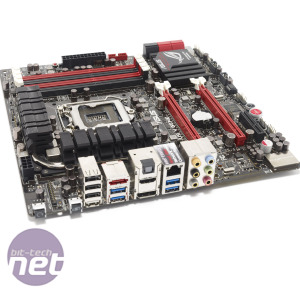Performance Analysis
It was with relish that we fired up the Maximus V Gene - the previous boards in this series have often differentiated themselves from the crowd in terms of performance, so we were hoping for a similar story here - who doesn’t love a pocket rocket of a motherboard after all. We were pleased then to see the Gene pull out a little bit of a margin over the reference Intel board and the Gigabyte Z77-UD5H that we tested it alongside in our image editing test.This good result was followed up however by slightly more mediocre results in the video encoding and multitasking elements of the benchmark suite - it even fell behind the Intel board in the latter. This slight blip wasn’t enough to stop the Gene taking the crown as the fastest Z77 board for everyday tasks, but it did mean that it’s victory wasn’t quite as unequivocal as we’d have possibly expected.
SATA performance also proved intriguing, as historically we’ve seen Asus excel in this area, much to the embarrassment of its competition. The landscape here has clearly changed though, with both the Intel and the Gigabyte board matching the red and black Asus effort. This isn’t to say that Asus has fallen behind of course, it’s more a case of other manufacturers finally catching up with Asus and getting their own SATA circuitry nailed down.
Gaming performance too saw little variation across the three boards - there was only a single frame per second separating them in both out ARMA II benchmark and our Shogun 2: Total War benchmark.
Thankfully things got a little more varied once we’d overclocked the boards, as this showed up the inherent abilities of each board better than stock speed testing. As you’d expect the results we got from the Maximus V Gene benefitted greatly from the extra CPU speed, jumping over 20% in our image editing test. This jump was matched by the Intel board, but not the Gigabyte board, meaning the Gene again rode out as winner.
The same cannot be said for overclocked performance in games however, as here we actually saw the Asus board fall behind the DZ77GA-70K and the Z77-UD5H. This was an unusual result, but was borne out in both the games we test in - the margins were, again, tiny however.
Conclusion
If we’re honest here, we’re a little disappointed - the Maximus V Gene doesn’t distinguish itself from the competition in terms of raw performance in the way its predecessors have. This is a shame, but it’s indicative of a mature market - Ivy Bridge and Z77 are, after all, only updates to Sandy Bridge and Z68. This means motherboard manufacturers have had a good old while to perfect their boards, while also aping the tricks and features of their competitors, leading to a homogenous market.It’s good then to see the Maximus V Gene distinguish itself in other ways, such as in its pricing, features and looks. In this regard the board is a success - at £150 it’s cheaper than the other two boards we’ve been testing (reviews soon). Granted you lose some flexibility in terms of expansion slots, but what you lose here you make up for in the ability to choose a smaller case. The board also looks great, especially with its clever backlighting arrangement. As a result we’ve no hesitation in giving the Maximus V Gene a great big gold star, but stay tuned over the coming weeks, as we’ll be looking at more Z77 boards and seeing if any can topple the dinky Gene.


MSI MPG Velox 100R Chassis Review
October 14 2021 | 15:04












Want to comment? Please log in.